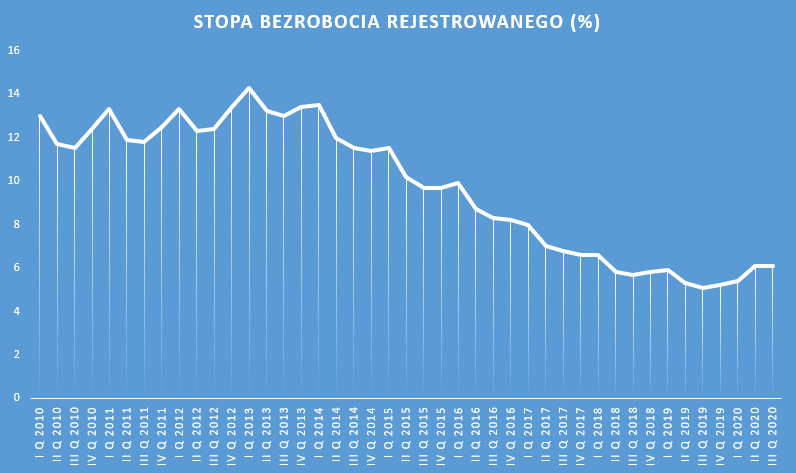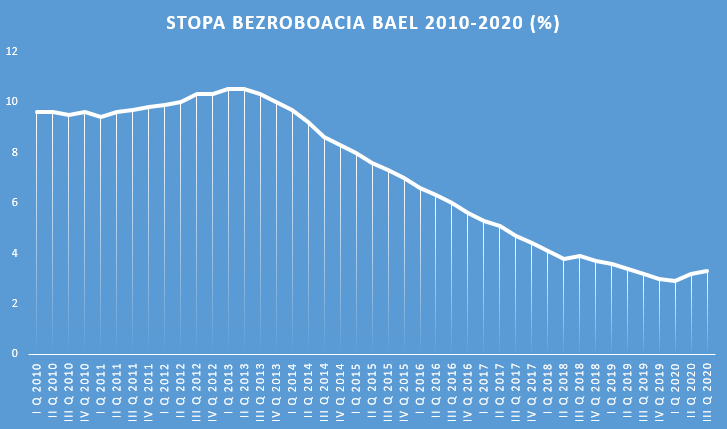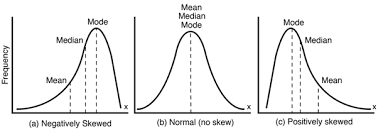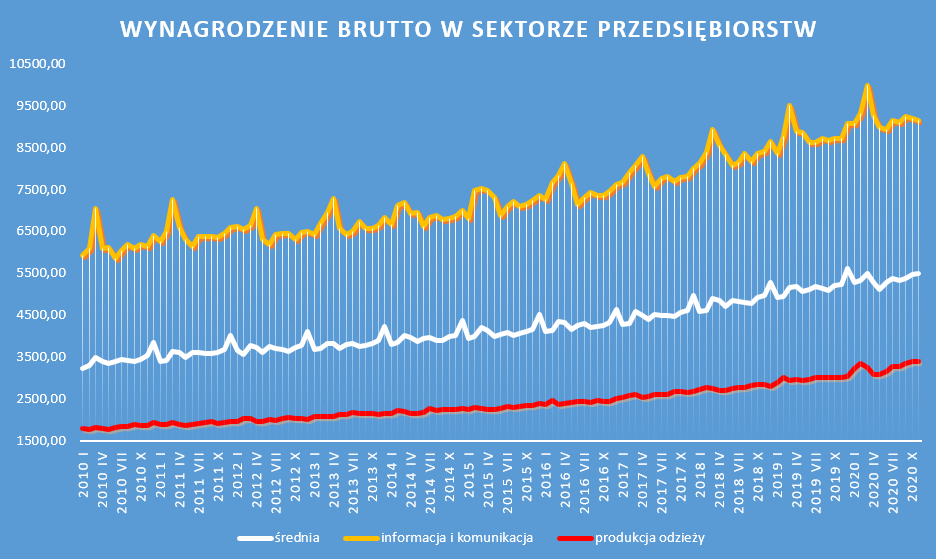Macroeconomic indicators - unemployment rate and average salary [part II]
Macroeconomic indicators are closely monitored by both institutional investors and analysts and retail traders. The enormous amount of information that they can provide us allows us to draw a number of conclusions about the current and past situation of countries, as well as to assess opportunities and future prospects. The key, however, is proper knowledge and a thorough understanding of what a given macro indicator is and what information it provides (and if not). After an article on inflation and GDPIt's time to enter the labor market. In this section we will discuss the unemployment rate and average salary.
Unemployment rate - qui pro quo
The unemployment rate is one one of the most popular and most commented on macroeconomic indicators. It often evokes a lot of emotions. In the case of the unemployment rate, it should be remembered that it is only an indicator that is supposed to approximate the situation on the labor market. Like any indicator, it has flaws that "distort the real picture." In the analysis of the unemployment rate, it should also be specified whether the "registered" unemployment rate or the unemployment rate calculated using the LFS is analyzed.
The most common accusation against this indicator is "manipulation" by governments trying to keep the unemployment rate as low as possible. The "key evidence" is the statistics of the employed, compared to the general labor force (people of working age). However, this is the classic "apples and oranges" comparison. The workforce includes people who live only on previously accumulated capital or who are homeworkers and are not looking for employment. Are such people the "real" unemployed?
The unemployment rate is one of the measures trying to determine the situation on the labor market in a given country or region. To understand how unemployment is calculated, you need to know the definition of an unemployed person and an active person.
An economically active person is any person of working age (labor force) who is employed, self-employed or classified as unemployed. In Poland, the working age has been set at 18-65 years for men and 18-60 years for women.
The group of employed or self-employed persons includes:
- Employers,
- Employees,
- Doing outwork,
- Agents,
- Basic military service soldiers,
- Clergy performing pastoral duties,
- Members of agricultural production cooperatives.
Jako unemployed person any remaining person is accepted without a job that is actively looking for employment and is ready to take it immediately.
Professionally active people do not include students in education, people living solely on capital and men or women taking care of the home.
An important indicator is level of professional activity, which measures the level of economically active people among people of working age. The level of this indicator is influenced, among others, by cultural factors. In societies with a conservative family model (the wife or partner is to take care of the children and the house), the rate will be much lower than in the societies preferring the partnership model.
Registered unemployment
The most popular method of measuring unemployment is the registered unemployment rate. It is a measure developed on the basis of registers kept by poviat labor offices. The definition of the unemployed was specified in detail in the Act on employment promotion and labor market institutions. A person defined as unemployed must be at least 18 years of age and no more than 60 years of age for women or no more than 65 years of age for men. Some additional criteria that an unemployed person must meet:
- She has not acquired the right to an old-age or disability pension (incapacity to work, school, social, family) in the amount exceeding half of the minimum remuneration for work,
- Has not submitted an application for entry in CEIDG,
- Does not maintain monthly income exceeding half of the minimum remuneration for work,
- Does not own an agricultural property with an area exceeding 2 ha,
- He is not a full-time student,
- Not in school (adult schools excluded),
- She is looking for or is ready to work.
For this reason, people who are not looking for this job cannot be counted as unemployed (search or readiness required). On the other hand, the register of the unemployed includes people working "illegally" who use registration with the office in order to have insurance. As you can see, this is not an ideal indicator.
LFS unemployment rate
Since 1992, the professional activity of the Polish population has been surveyed by the Central Statistical Office (GUS) with BAEL (Study of the Economic Activity of the Population). The survey carried out by the Central Statistical Office is part of the European LFS (Labor Force Survey) project, i.e. the European Labor Force Survey. When measuring activity using LFS, the interviewers visit over 30 households and interview 000 people.
According to BAEL, people were classified as employed operated for at least 1 hour during the period considered and were paid for it. This meant that they were employed, self-employed or worked on their own or leased farm. To people working include, among others family memberswho, without an agreed remuneration, helped in running the family business. To people working also include people who had work, but did not perform it (e.g. due to illness, maternity, parental or holiday leave) or for other reasons, if the work break was up to 3 months.
The unemployed were classified as people aged 15-74 who meet the conditions:
- They had no work during the surveyed week,
- They were actively looking for her,
- They were ready to work within two weeks of the survey.
The unemployed also included people who were unemployed, but confirmed that they have a "job done" which they will start within 3 months.
Passive people professionally, it is a group of people aged 15 to 74 and meeting the following conditions:
- During the audited week, they were not employed,
- They were not working, were looking for a job, but were not ready to take it within two weeks of the study,
- They were not looking for a job, had no job or had a 'job done' but expected to start it in a period longer than 3 months.
Among the economically inactive, there is also a group defined as "discouraged". People who are not looking for a job belong to it, because they are convinced that they will not find it anyway.
Below is a chart of the unemployment rate calculated using the BAEL method. Data are seasonally adjusted:
Unemployment and the economy
The level of unemployment has a large impact on many factors: from earnings in the economy to public mood. The falling unemployment rate increases the pressure on employers. Competition for employees forces wage increases.
A significant increase in wages encourages entrepreneurs to look for savings. One of the solutions is to attract immigrants (e.g. an influx of workers from Ukraine and Belarus to Poland) who are ready to work at a lower price. The second way is to automate your work processes more to pay more money but fewer employees (increased productivity). Automation may apply to both physical (e.g. in a car factory) and intellectual (e.g. in accounting) work.
If a company cannot quickly automate its processes or attract cheaper employees from abroad, employers are forced to raise their prices or drop their margins. If an enterprise decides to raise prices, the inflationary pressure in the economy increases. In the event of an increase in remuneration, exporters find themselves in a more difficult position, as in the absence of other changes, the unit price of a product or service increases.
Another positive aspect of the decline in unemployment is the increase in consumption in the economy. The improvement in the standard of living of households translates into increased purchases in various sectors - from entertainment, through travel, clothing, to education.
In the case of an increase in unemployment, inflationary pressure is reduced, retail sales weaken and processes increasing the organizational effectiveness of the enterprise are postponed, in line with the principle "why modernize when labor costs are low".
Average salary
Under the average wage articles, you can often find comments like "that's a lie, I don't know anyone who earns that much" or "the average is lying! On average, my dog and I have three legs.
The average is not an ideal indicator, it is a simplification of reality. If the imperfect indicator is applied to such a sensitive topic as wages, the risk of misinterpretation and unnecessary emotions increases. It is necessary to understand that the mean most often is not the same as the median. On the other hand, the median is usually different from the dominant.
In order to understand the relationship between the data, it is necessary to recall a few statistic formulas.
arithmetic average is a calculated value by summing a set of values and dividing it by the number of elements in that set.
Median that's the middle value. This means that the median divides the harvest into two halves. Above and below the median value there is an equal number of items (observations). It is the median that comes closest to the intuitive term "mean". In specific situations, the mean is equal to the median. However, this is not the case with earnings.
Dominant instead it is the most common value in the given set. In the case of the sequence of numbers: 1,1,2,2,2,5,7,100, the dominant number is the number 2 which appears 8 times in the 3-element set.
The relationships between the mean, the median, and the mode depend on the skewness of the system. Below is a diagram showing the left-skewed (negatively), symmetrical (normal) and right-skewed (positively).
If the schedule is symmetrical it means that the mean is equal to the median and this is equal to the dominant. It is a very rare deal in the economy.
Schedule right-skewed is a situation where the data distribution "spans" to the right. The top of the distribution is shifted to the left, while there is a very large "tail" to the right of the graph. This is a situation where the mean is greater than the median, and this is greater than the dominant.
Schedule left oblique is a situation where the data distribution "stretches" to the left. The top of the distribution is shifted to the right, but there is a very large "tail" to the left of the graph. It is a situation where the mean is less than the median, and this is less than the dominant.
In the case of wages, this is a situation where the distribution of earnings is right-skewed. This means that the median earnings are below the average. This is due to a very large "right tail", that is, the few employees who earn a lot. This causes the average to "inflate".
In Poland, data is prepared by the Central Statistical Office (GUS) and published monthly. The salary applies to the sector of enterprises with more than 10 employees. The value of the average salary is given in gross amount. At the same time, the remuneration applies only to persons employed under an employment contract. As a result, the above-mentioned statistics do not include:
- Micro-enterprise employees,
- Self-employed,
- Employed under civil law contracts.
This means that the average is calculated only from a certain segment of the entire labor market. Among others, specialists working on their own business, freelancers using contracts of mandate and for specific work, as well as employees of very small companies.
As a result, the average wage index can be considered as an index reflecting the situation on the labor market "roughly". In a situation of falling unemployment and economic growth, the indicator will increase, while during long recessions and rising unemployment, the indicator will most likely perform much weaker.
The average salary indicator is important for people running a business. It is from this ratio that the basis for calculating health and social insurance contributions is calculated. For a person running a business (without tax allowances), the basis for calculating social security contributions is 60% of the forecast average salary. In the case of the health insurance contribution, the calculation basis is 75% of the forecast average salary.
Every two years, the Central Statistical Office publishes data on the median and the dominant position of earnings in Poland. According to data collected in October 2018, the median was approximately PLN 900 lower than the average (PLN 4095 vs. PLN 5004). In turn, the dominant was approximately PLN 2380, which was PLN 280 higher than the minimum wage in October 2018 (PLN 2100). However, it should be remembered that the dominant feature in such large data sets has little interpretative value, so it can be omitted in the analysis of employee earnings. Below is a chart showing the change in gross salary in the enterprise sector.

Source: own study based on the data on stat.gov.pl
The difference in average wages between the various sectors is very large. This is clearly seen in the chart below, which compares the enterprise sector average with the garment (red) and communication and information (orange) sectors.
Average remuneration and the economy
Average remuneration is an indicator that allows you to track changes in remuneration in a defined research group. At the same time, it can be a point of reference for people who change and look for a job. The increase in average wages is related to the general situation on the labor market. If the unemployment rate drops, the wage pressure increases. This, in turn, translates into an increase in wages in the economy. The increase in wages and salaries increases consumer demand, which should be visible in the data on retail sales.






















![Forex Club – Tax 9 – Settle tax on a foreign broker [Download the Application] Forex Club - Tax 9](https://forexclub.pl/wp-content/uploads/2024/02/Forex-Club-Podatek-9-184x120.jpg?v=1709046278)
![Trading View platform – solutions tailored to the needs of traders [Review] trading view review](https://forexclub.pl/wp-content/uploads/2024/03/trading-view-recenzja-184x120.jpg?v=1709558918)
![How to connect your FP Markets account to the Trading View platform [Guide] fp markets trading view](https://forexclub.pl/wp-content/uploads/2024/02/fp-markets-trading-view-184x120.jpg?v=1708677291)
![How to invest in ChatGPT and AI? Stocks and ETFs [Guide] how to invest in chatgpt and artificial intelligence](https://forexclub.pl/wp-content/uploads/2023/02/jak-inwestowac-w-chatgpt-i-sztuczna-inteligencje-184x120.jpg?v=1676364263)




![Izabela Górecka – “Success on the market depends not only on knowledge, but also on emotional stability” [Interview] Izabela Górecka - interview](https://forexclub.pl/wp-content/uploads/2024/04/Izabela-Gorecka-wywiad-184x120.jpg?v=1713870578)
![WeWork – the anatomy of the collapse of a company valued at $47 billion [WeWork, part II] wework bankruptcy story](https://forexclub.pl/wp-content/uploads/2024/04/wework-bankructwo-historia-184x120.jpg?v=1711729561)
![Adam Neumann – the man who screwed up Softbank [WeWork, part AND] adam neumann wework](https://forexclub.pl/wp-content/uploads/2024/04/adam-neumann-wework-184x120.jpg?v=1711728724)




![The most common mistakes of a beginner trader - Mr Yogi [VIDEO] Scalping - The most common mistakes of a beginner trader - VIDEO](https://forexclub.pl/wp-content/uploads/2024/03/Scalping-Najczestsze-bledy-poczatkujacego-tradera-VIDEO-184x120.jpg?v=1711601376)
![Learning patience: No position is also a position - Mr Yogi [VIDEO] Scalping - Learning patience - No position is also a position - VIDEO](https://forexclub.pl/wp-content/uploads/2024/03/Scalping-Nauka-cierpliwosci-Brak-pozycji-to-tez-pozycja-VIDEO-184x120.jpg?v=1710999249)
![When to exit a position and how to minimize losses - Mr Yogi [VIDEO] Scalping - When to exit a position and how to minimize losses - VIDEO](https://forexclub.pl/wp-content/uploads/2024/03/Scalping-Kiedy-wyjsc-z-pozycji-i-jak-minimalizowac-straty-VIDEO-184x120.jpg?v=1710336731)



![Macroeconomic indicators - unemployment rate and average salary [part II] unemployment rate average salary](https://forexclub.pl/wp-content/uploads/2021/01/stopa-bezrobocia-srednie-wynagrodzenie.jpg?v=1611568719)







![Macroeconomic indicators - unemployment rate and average salary [part II] swipe sxp crypto](https://forexclub.pl/wp-content/uploads/2021/01/swipe-sxp-crypto-102x65.jpg?v=1611566238)
![Macroeconomic indicators - unemployment rate and average salary [part II] gamestop reddit actions](https://forexclub.pl/wp-content/uploads/2021/01/gamestop-akcje-reddit-102x65.jpg?v=1611652962)










Leave a Response